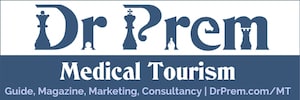Medical tourism is truly a gold churnerand can play a big role in a country’s economic goals. But, a country’s promotional efforts to boost medical tourism could flop unless framed on well-thought target-oriented marketing strategies that will help to sustain in the competition driving in the expected growth.
In the medical sector, every country has a definite capacity but in an exuberance to promote medical tourism without factoring this crucial factor is sure to backfire. This has just happened with Singapore and Israel. These two countries are modern, affluent and have a huge potential to bring in up gradations in its healthcare infrastructure, but they no longer continue to enjoy the supreme positions as medical tourism destinations.
Medical tourism is a great revenue earning avenue, but healthcare should not be treated as a high-priced commodity accessible only by the well heeled and well insured defeating the basic humanitarian objective of cure and support for all.
Prior to promoting medical tourism, what is important is that a lot of spade work need tobe done in the following areas:
Proper assessment of capacity:
It is important to investigate whether the country promoting medical tourism has the surplus potential to take on additional crowd from other countries. Handling medical tourists from abroad can be possible only if a country has surplus capacity in quality service of a particular treatment(s) and a strong supportive infrastructure. Estimation of available surplus capacity which can be allocated to foreign patients is of crucial significance.
Presently, India doesn’t have more than 15 % of surplus capacity in some specific medical domains that can be shared with foreign patients. In this light, the Indian Medical Tourism board should frame workable strategies as well not losing foresight and neither overlooking the necessity of assessing surplus healthcare potential.
Safeguarding home patients:
Quality medical treatments offered to foreign medical tourists should not displace the requirements of domestic patients, which is quite likely if a country fails to assess its foreign medical tourist handling capacity. Notably, Ontario has taken a strict move to regulate the freedom of hospitals in attending foreign medical tourists. Israel too is losing its ground on medical tourism with the implementation of strict healthcare regulations where the national patients are given the top priority in treatment.
If a country’s major share of healthcare services are booked out to foreign customers with a mindless race for earning foreign currency, where the local patients would go? Apparently two situations would arise:
– Those who can afford would look for foreign healthcare options and that is an outflow of domestic currency into foreign hands. This certainly beats the purpose of medical tourism draining the national exchequer.
– Those who cannot afford would suffer for want of medical facilities sold out to foreigners. This is even worse and would jeopardize the existence of the ruling government!
Identifying the target market and customers:
Assessment of potential should again be further supported by the identification of customers and their ability to pay the price set for curing anailment.If a country is affluent enough with the state-of-the-art medical technologies in hand, it must have put in a substantial investment to make their product attain a quality that is the best in the world. In such cases, the country should promote those complex highly sophisticated treatments. Not all the foreign customers have the capacity to pay the price quoted in a complex surgery.
Customer identification is a crucial factor. The country should only focus on complex surgeries as an export product instead of starting a marketing hype that they are great at curing all kinds of ailments. It will simply not work that way. Patients from average economic bracket not looking for complex surgeries would find the deal way too expensive.
Consequently, they would look for other low cost destinations where the presence or absence of the best specialists will not make any difference. At the bottom line lies the horror of a wrong estimation of capacity assessment. It is quite obvious that all those heavy investments made to boost up the healthcare system would simply have a negative effect on the country’s economy if not passed on to customers with that level of paying capacity.
It has been observed that Thai, Indonesian and Malaysian patients who were so obsessed with being treated in world class clinics in Singapore, their affluent neighbor, have turned much disillusioned.They find Singapore to be too pricey. Rather back home with the healthcare system much upgraded they can achieve the same quality of treatment at a much affordable price.
Considering the highly competitive medical tourism market, two most important factors of quality and price of medical services cannot give a solution in their individual capacity alone. A trade-off needs to be achieved where the price and quality touches the optimal point drawing in maximum number of medical tourists from foreign countries.
Thus, it is a different type of ball game that should be played with the following strategies:
– An insightful analysis of the market .
-Customer segmentation
– Identifying surplus capacity
– Identification of strength and weaknesses in the domain of healthcare system inherent in a country.
– Existence of supporting infrastructure like travel, logistics, food, and accommodation at fair prices.
– And finally, pin pointing that specific area in the field of healthcare service where the country is the unbeatable champion; a specialized surgery for example, where no other country can match up both in terms of quality of treatment and fairness of price. Even if the price is quoted a bit on the lower side, the huge volume of incoming foreign patients can more than make up for price relaxation.
The areas of strength need to be fortified with further investments in manpower, equipments and marketing. While the areas of healthcare service which have lesser chances of further generation of revenue from foreign customers should rather be diverted to delivering quality service to domestic patients to check outbound medical tourism making them avail the treatment in home soil.
Clearly, Singapore is losing ground due to stiff competition from neighboring nations. A hip surgery in Singapore would run into around 14000 USD while in Malaysia it would cost around 8800 USD keeping the quality of treatment delivery the same. So why should a patient from Malaysia come all the way to Singapore?
He would prefer the low-cost treatment available in home soil. On the other hand, patients from other countries would also catch the flight to Malaysia than Singapore considering the quality-cost trade off. With accommodation and flight expenses, the entire deal would push up to unmanageable limits for a common man. Marketing strategies should incorporate these features which are very fundamental to any marketing tourism industry.
Marketing your world class medical treatment facilities is fine. However, you should never lose sight of the country from where your targeted customer segmentation hails from and the availability of the quality healthcare system that exists in those countries. If foreign customers find a marked quality and price advantage being offered by your country, he will move in else he would decide to stay back and get treated at home or choose another destination offering nearly the same quality treatment but at a much-reduced price.











